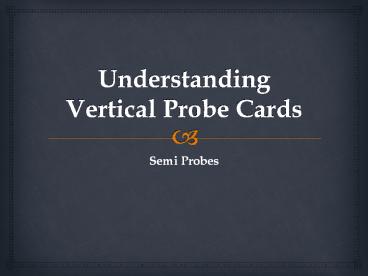Understanding Vertical Probe Cards (1) - PowerPoint PPT Presentation
Title:
Understanding Vertical Probe Cards (1)
Description:
When contacting solder bump vertical probe card, a flat tip is always utilized; when contacting aluminum surfaces, a pointed tip is better since it will penetrate any oxide layer; and when contacting gold surfaces, both pointed and flat tips can be used. – PowerPoint PPT presentation
Number of Views:14
Title: Understanding Vertical Probe Cards (1)
1
Understanding Vertical Probe Cards
- Semi Probes
2
- Vertical-contact probe cards for wafer testing
have several advantages, including full array
testing and high parallel probing flexibility.
Regardless of how the pads are arranged, several
dice can be probed and examined at the same time.
Parallel testing procedures can significantly cut
costs.
3
Full -Array Probing
- The widespread use of flip-chips and other array
bumping techniques necessitates the contact of a
large number of pads on a single square
centimeter. Because of the physical limits
imposed by the needle's horizontal arrangement,
this application cannot be carried out with epoxy
ring probe cards. - Increasing the throughput of a probing line
lowers test costs and, lowers manufacturing
costs. As a result, the goal is to test as many
chips as feasible at the same time while reducing
the number of touchdowns per wafer. The pads on
the wafer must be placed in specific patterns for
epoxy ring probe cards, due to physical
limitations in the horizontal placement of the
needles, parallel probing was adopted. Parallel
probing with epoxy ring probe cards are
frequently required to be factored into the chip
design. This highlights a few drawbacks in the
use of parallel probing.
4
High-Temperature Range
- During the die test, the temperature range
gradually widens. Temperatures of 0 to 125C are
necessary for numerous sorts of probing
procedures. In this case, too, the traditional
probing card technology demonstrates its
limitations. In terms of thermal behavior, the
construction of a needle card is exceedingly
intricate and difficult to control. - Higher probing requirements can be met with
vertical-contact probe cards. The buckling-beam
principle is the foundation for a vertical probe
card (or buckling wire). The bending or buckling
of columns is defined by mathematical formulae as
a function of loads applied to them. This
relationship demonstrates that if a force is
applied to the wire's end, the wire will bend and
generate a spring force that is nearly
independent of the wire's displacement. The force
graph is constructed as a function of
displacement for a buckling wire and a
compression spring as a comparison. A significant
non-linear spring characteristic is achieved,
resulting in homogeneous force distribution over
all contacts of a vertical probe card, in
contrast to the spring concept of a needle card.
5
Vertical Probing Assembly
- The ViP head, which contacts the wafer (DUT), and
the ViP connection, which ensures good contact to
the PCB, make up the vertical probing assembly.
The ViP head is made up of guide plates that are
drilled to match the wafer footprint. The holes
must be placed with exceptional precision to
ensure high probe positioning accuracy of the
buckling wires. The ViP head's buckling beams
align perfectly with the wires in the ViP
connector, ensuring great contact. This design
also makes it easy to change the ViP head for
maintenance. The following capabilities were
given significant consideration during
development high density probing flexible,
parallel probing the high accuracy of contact
points and suitability for high-temperature
ranges.
6
High-Density Probing
- The vertical technology allows for the precise
arrangement of thousands of contacts on a postage
stamp's surface. Buckling beams (spring wires)
that have been specially made are positioned in
guide plates that have been perforated according
to the footprint of the DUT. There are two types
of vertical probe tip shapes flat and pointy.
When contacting solder bump vertical probe card,
a flat tip is always utilized when contacting
aluminum surfaces, a pointed tip is better since
it will penetrate any oxide layer and when
contacting gold surfaces, both pointed and flat
tips can be used. Parallel probing reduces test
time by a significant amount. If the contact
pattern can be easily modified according to the
intended parallel test strategy, the vertical
probe card is especially ideal for parallel
probing. This is accomplished by drilling a guide
plate based on the DUT's footprints. Parallel
testing must be factored into the wafer design.
7
In Short
- ViProbe can be used to probe memory wafers in a
variety of ways, including array probing,
peripheral parallel probing, and multi-die
probing. When it comes to array probing, the
ViProbe is particularly well suited to full array
probing, such as on flip-chip wafers. Semi Probe
offers a wide range of probe cards and
accessories, check out for details.
8
THANK YOU































